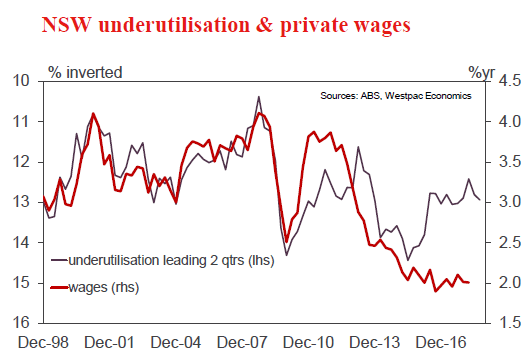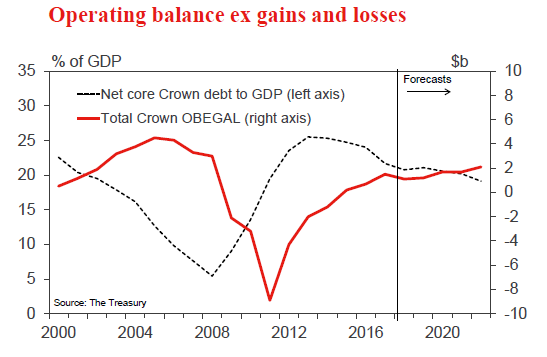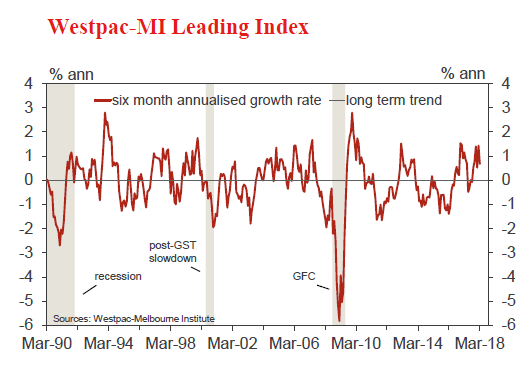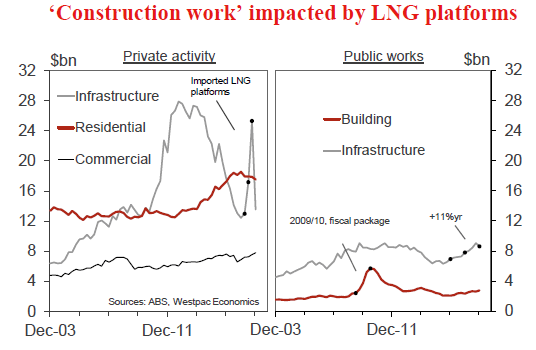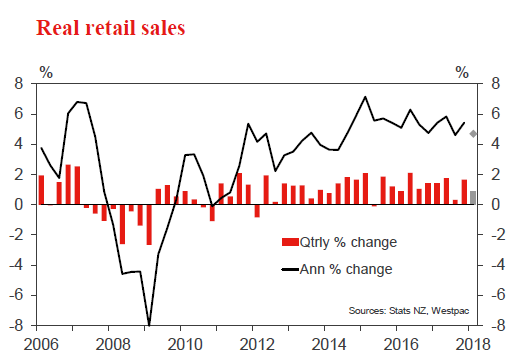Week beginning 21 May 2018
- Wages and confidence data supports Reserve Bank’s more cautious approach.
- RBA: Governor Lowe, Assistant Governor Bullock speak.
- Australia: Westpac-MI Leading Index, construction work.
- NZ: retail sales, trade balance.
- Euro Area: consumer confidence.
- US: FOMC minutes, durable goods orders, new & existing home sales.
- G3: flash PMIs.
- Key economic & financial forecasts.
Information contained in this report current as at 18 May 2018.
Wages and Confidence Data Supports Reserve Bank’s More Cautious Aapproach
The minutes of the May monetary policy meeting of the Reserve Bank Board repeated the assertion that first appeared in the April minutes. That is that “members agreed that it was more likely that the next move in the cash rate would be up rather than down”. This observation is contingent on the economy evolving in the way the Bank currently expects which is “a gradual pick-up in inflation as spare capacity in the economy is absorbed and wages growth gradually picks up”. Nevertheless the Board observed that spare capacity in the labour market would remain for some time.
Using this terminology might create challenges for the Bank in the future. If the term is ever deleted from the minutes, markets are likely to take that as a sign that the Bank’s policy stance has changed.
Note the “bold” move from the new Governor of the RBNZ (Adrian Orr). He lowered his growth and inflation forecasts and stated, “the Official Cash Rate (OCR) will remain at 1.75 percent for some time to come. The direction of our next move is equally balanced, up or down”.
The Reserve Bank of Australia however did not lower its growth or inflation forecasts in its recent Statement on Monetary Policy but did make a subtle change in the rhetoric of the minutes, “it would be appropriate to hold the cash rate steady and for the Reserve Bank to be a source of stability and confidence”.
That implies a ‘badge of honour’ to have steady rates, rather than a stance that needs to be justified in a world where other central banks are tightening policy. Perhaps the lead from the RBNZ, who have recognised the risks around the current environment, has had some impact on their thinking.
The clear positive development for the economy has been the strong boost to non-mining business investment particularly non-residential construction and government public works. The Bank is justified in expecting that this strong momentum will be sustained although in our view at a decreasing pace. We expect that non-residential construction which added 0.6 percentage points to GDP growth in 2017 will gradually reduce its contribution to GDP growth to 0.33 percentage points in 2018 and 0.19 in 2019. Equally we also see government public works spending will also grow but at a slowing pace contributing 0.4 percentage points in 2017, 0.31 in 2018 and 0.23 in 2019.
There remains the concern that wage pressures may take some time to emerge. Indeed Deputy Governor Debelle highlighted a key risk to the Bank’s outlook in his speech on May 15. He nominated that risk as being that the level of the unemployment rate needed to spark wage and inflation pressures might be lower than the Bank’s current unemployment forecast. Note that this is a fairly cautious 5.25% (from current 5.6%) by June 2019 and remaining there through to the end of the forecast period by June 2020.
In fact this forecast represents a downgrade of the unemployment outlook. In the February Statement on Monetary Policy the forecast was for the unemployment rate to fall to 5.25% by June 2018 – a full year earlier than the current forecast. In that sense the Bank has actually downgraded an aspect of its growth outlook. This presumably reflects the slowdown in jobs growth we have seen in 2018 with the four month annualised pace slowing to 1.3% from overall growth in 2017 of 3.4%.
These cautious forecasts of the unemployment rate must indicate that the Bank is aware of the risk that the labour market does not tighten sufficiently to boost wages and other incomes. In fact general estimates of the so-called full employment rate (NAIRU) have been around 5% for Australia. In other countries, their traditional NAIRU estimates have been downgraded in the aftermath of the GFC.
Certainly there is still no sign of any lift in wage pressures. The March quarter wages report printed on May 16.
Total hourly wages ex bonuses rose by 0.5% in Q1 compared to a median of market expectations (and Westpac’s) of 0.6%. This is the second quarter of a disappointing wage print, Q4 WPI rose 0.6% compared to a median expectation of 0.7%. The Q4 print was also revised down to 0.5% from 0.6% as it was originally reported. These modest wage outcomes leave annual private sector wages growth “stuck” at 1.9% despite the 3.3% increase for the minimum wage as determined by the Fair Work Commission.
The Board discusses this prospect when it talks about the wage price index not picking up as quickly as in the past when business surveys identified some shortage of suitable labour. The Board discussion moved to international evidence which shows similar inertia in wages and they discussed possible reasons including competitive pressures from globalisation and technological change. We would add: low productivity growth; falling unionisation; high household debt which constrains job mobility and lack of pricing power generally in the economy. As one employer noted “Why should I grant a pay rise if I cannot compensate with a price rise”?
There may be some source of embarrassment in the minutes in that it is noted that “recent data on retail” suggested that momentum had continued in early 2018. Since the Board meeting, the retail sales report showed that real retail sales had grown by a very modest 0.2% in the March quarter.
This downbeat take on the consumer was further supported by the Westpac Melbourne Institute Index of Consumer Sentiment. The May Report showed a further modest deterioration.
This followed the well-received Commonwealth Budget which included personal tax cuts; savings largely explained by tighter scrutiny of the black economy (few specific losers) and an improved fiscal position. The modest 0.6% fall came as a surprise. It was underpinned by a 6.5% fall in the sub Index (household finances compared to a year ago) and although the Budget boosted confidence in the near term economic outlook, it failed to spark interest in respondents’ assessments of their finances.
In the minutes, there was a more detailed discussion on the outlook for housing. In particular, the Board notes that “a further tightening in lending standards in Australia, particularly in the context of the current high level of public scrutiny of Banks, was possible which would affect household borrowing and spending”. The recent release (since the Board meeting) of housing finance data showing that new lending to investors was now down 26% over the year (and 30% from the peak) is certainly consistent with those concerns.
That clearly signals a slowing in credit growth and the Deputy Governor, in his speech, acknowledges that likelihood. The issues are not only around reduced confidence amongst investors but an impact on the amount of funds an individual can borrow. Deputy Governor Debelle postulates that such a tightening has implications for house prices more than consumption. We do not think that argument is strong. For example note the significant impact on household finances in the Consumer Sentiment survey partly reflecting weaker housing – it is risky to assume little wealth effect when prices fall just because it seems to be muted when prices rise.
The Deputy Governor does address the issue of the implication for a fragile housing market if the RBA raises rates. He notes that an environment where rates are rising would “highly likely to be one where wages and household incomes are growing faster than currently, improving the ability of households to afford higher mortgage payments.” That is a reasonable argument and does demonstrate that the Bank is mindful of the impact of increasing rates on a fragile housing market.
Westpac continues to expect that the Bank’s policy of “stability and confidence” (rates on hold) will be maintained throughout 2018 and 2019.
The week that was
The past week has been a quieter one for data, although significant moves have been seen in US long-term interest rates and the US dollar.
First for Australia, the Westpac-MI consumer sentiment survey was released for May. This release held additional significance, being the first gauge of sentiment following the Federal Budget 2018. Sentiment declined 0.6% overall to 101.8. However, the sample detail pointed to a positive response among consumers from the Budget, with views recorded after the Budget 4.9% higher than those before – the biggest positive turnaround seen since we started tracking the before and after sub samples back in 2011.
Similarly, the Budget question which tracks the Budget’s effect on family finances was also the strongest recorded since 2010. 10% expect the Budget will improve their finances; 58% expected no change; and 13% reported they don’t know. More broadly, it remains the case that consumer sentiment is being held up by views on the economy (which are above average) despite enduring concerns over family finances. On housing, ‘time to buy’ has fallen to a six-month low, 15% below the long-run average. House price expectations however remain just above the long-run average nationally, albeit are noticeably weaker in Sydney.
The persistent concerns over family finances arguably stem from poor wage prospects, which this week’s other key data again emphasised. The April labour force survey reported that employment bounced back in the month, rising 22.6k after the loss of around 8k jobs in February and March, leaving annual and six-month annualised growth at a still-strong 2.7%yr and 2.5% respectively.
In stark contrast however, the wage price index disappointed in the March quarter, rising just 0.5% to be up 2.1% over the year, just above the historic low for the series. Wage growth in the private sector remains weaker than in the public sphere, with respective annual growth of 1.9%yr and 2.3%yr. Importantly, by state and sector, weakness in wages is broad based. Of the states, the Northern Territory is the slowest at 1.1%yr and Tasmania the strongest at 2.3%yr. By industry, heath & social services is the best performing industry at 2.7%yr, while mining is the weakest, 1.4%yr.
These wage outcomes are much weaker than the unemployment rate and employment growth indicate they should be. Instead the weakness in wages is coming as a result of the underutilisation of labour resources and structural factors (the use of technology and firms’ seeking efficiency wherever possible). Underutilisation not only includes those who are unemployed, but also those who are working less hours than they would like.
Importantly, this ‘slack’ does not end there. There is an additional pool of workers who are not currently opting out but would re-enter for the right opportunity. Stronger conditions would therefore result in greater participation and increased supply.
In terms of the implications for the RBA and monetary policy, see Bill’s piece on the previous page.
Turning to New Zealand, Budget 2018 was delivered there this week. Our NZ team have provided a detailed review as well as an essay on the following page.
For the US, it has been a quiet week for data, with only retail sales worth a mention. Headline sales were a little below our expectation in April at 0.3%, but positive revisions to February and March made up the difference. As we have noted on a number of occasions, the consumer’s contribution to growth in 2018 will be less significant than in recent years, with business investment and government spending instead to make or break the growth outturn.
We have however seen some interesting moves in US financial markets this week. The 10yr Treasury yield jumped back through 3.00% and currently looks settled around 3.10%. Also the US dollar has continued its uptrend, up another 1.0% this week to be 5.5% higher than the mid-February low.
Whereas gains like these for US yields and the dollar adversely affected equities earlier this year, in this instance equity investors have shown little-to-no concern, with the S&P500 broadly unchanged compared to this time last week.
Likely providing comfort to equity markets is the steady guidance being offered by members of the FOMC and regional Federal Reserve Banks. Put simply, their expectation remains for a gradual rise in the fed funds rate, but only if above-trend growth continues and the labour market tightens further.
Chart of the week: Q1 NSW wage price index
Wage growth remains weak and remarkably so across industries, sectors and states. At a national level, the only real sign of any lift in wages is from the public sector, particularly in Victoria, with a focus mostly in health services. Even in education, that was performing as strongly as health services, the pace has started to ease back.
Key to the underperformance overall has been the significant underperformance of NSW wages relative to a meaningful tightening in labour market conditions there. Despite a significant fall in underutilisation in that state, private sector wages continue to languish around 2%yr. Add to that the relative underperformance in public sector wages then you can see why wages remain relatively soft overall.
New Zealand: week ahead & data wrap
The “patient” Budget
All eyes were on this week’s maiden Budget from the Labour-led coalition Government. In the end it was a rather bland affair. The stronger than expected economy delivered extra tax revenue, but this was promptly gobbled up by increased health spending, leaving the crumbs to be scattered across a range of smaller initiatives in other sectors.
This week’s Budget followed a similar script to the final few Budgets under the previous Government. The economy has proved stronger than expected, and that has delivered surprisingly strong tax revenue. But the Government has found that delivering the health outcomes people want is more expensive than forecast. So most of the extra money was channelled into health, and there was precious little left over for anything else. Labour kept its coalition partner happy by boosting funding for ministries headed by New Zealand First politicians, and education got most of the remainder.
Initiatives announced in the health sector included extending free GP visits to children under 14 years old, and a $20-$30 reduction in the cost of GP visits for community service card holders. In education, the focus shifted toward childhood education from tertiary education, giving much more bang for buck. However, the quantum was disappointingly small. Especially when compared to the money poured into free tertiary education and bigger student allowances at last year’s Half Year Update which will do much less for society as the benefits mostly accrue to people who are already doing relatively well.
The Government stuck to its self-imposed Budget Responsibility Rules. We think that was appropriate. The economy is in a bit of a sweet spot, so now is the time to save for a rainy day. The future might hold a recession or a natural disaster, and we know that the aging population will be hugely expensive. A line in the sand is also a good way to avoid white-elephant spending by encouraging prioritisation within a spending limit.
One of the responsibility rules, perhaps the only binding one, is to bring net debt below 20% of GDP within five years of taking office. With only slightly smaller accumulated surpluses, and no new capital spending, there was little change in the forecast for net core Crown debt after five years. The latest projections see it drop to 19.1% of GDP by 2022, leaving the government with some wiggle room.
That might prove useful if, as we expect, growth disappoints relative to Treasury’s projections. Although the Treasury’s growth forecasts are a little softer in the near-term, they still have a reasonably strong outlook over the next five years, with GDP assumed to average close to 3% per annum. We expect that both nominal and real GDP growth will undershoot the Treasury’s forecasts. That signals some associated downside risks for tax revenue collections and projected surpluses.
The other place the Government has generated a bit of wriggle room is by plans to increase borrowing by Crown entities. This borrowing is technically not counted as core Crown debt, though it is a bit of a grey area. For example, Housing New Zealand intends to borrow in its own name to fund the building of new state houses, with the trade-off that it may end up paying a higher interest rate than if the investment had been funded by central Government. This switch won’t fool investors who lend money to NZ or ratings agencies who will also keep an eye on total borrowings as well as those strictly defined as core Crown debt. The more borrowing these entities do, the more likely it is to appear on the radar, but we’re probably not at that point yet.
The ramp up in spending in this Budget will have inflationary consequences for the economy. Treasury thought these would be significant, and forecast OCR hikes from the end of this year. We view any inflationary consequence as more minor, and more likely to take effect in later years, so we won’t be changing our own expectation of the first rate hike in November next year.
One of the risks identified in the Budget was the cost of dealing with the Mycoplasma bovis outbreak – a disease recently discovered in New Zealand for the first time which affects the health of cattle. It makes some sense to note this as a risk as neither the extent of the problem, nor the best response, has been determined yet. But it’s also worth noting that the situation has deteriorated in the weeks since the Budget was signed off, with evidence that the disease becoming more widespread throughout the country. These developments have probably swung the dial in favour of farmers learning to manage the disease rather than attempting to eradicate it. Yet, whichever way the decision goes, already fragile confidence in the dairy sector has taken yet another knock.
Overall, it was a bland Budget, but we think that was appropriate. New Zealand’s economy is in a fairly sweet spot, so now is the time to save for a rainy day. It also leaves the Government with enough tucked up its sleeve for the remainder of its term. So while today’s Budget may have been a largely business as usual document, next year’s could be a different beast, once the Living Standards Framework is integrated and the working groups on tax, education and social welfare report back with policy ideas.
Data Previews
Aus Apr Westpac-MI Leading Index
- May 23, Last: +0.69%
The six month annualised growth rate in the Leading Index fell from +1.43% in February to +0.69% in March. While down, the growth rate is still in positive territory, signalling above trend momentum over much of the remainder of 2018. Drivers of the slowdown were domestic – a slowing labour market; and some weakness in housing while rising short term interest rates have reflected liquidity pressures from global markets.
The April read will include mostly positive component updates, including: the ASX200, up 3.9% vs -4.3% last month; the Westpac-MI Consumer Expectations Index, up 0.8% vs -0.9% last month; US industrial production, up 0.7% vs 0.7% last month; dwelling approvals, up 2.6% vs -4.2% last month; the Westpac-MI Unemployment Expectations Index, down -4.5% vs 3.1% last month; and total hours worked, up 1.1% vs 0.2% last month. The drag from narrowing yield spreads has also moderated although global commodity price moves have been less positive (down -3% in AUD terms vs 2% last month).
Aus Q1 construction work
- May 23, Last: -19.4%, WBC f/c: 0.7%
- Mkt f/c: 1.3%, Range: -2.0% to 5.0%
Recently, the Construction Work survey has been impacted by imported LNG platforms. The survey includes their full value when imported, rather than actual work in the period, as in the national accounts.
‘Construction Work’ rose 9.8% in Q2 and climbed a further 16.6% in Q3 (boosted by imports of platforms), then reversed 19.4% in Q4.
For Q1, we expect a small rise of 0.7%, anticipating no further impact from LNG platforms.
Upswings in public construction and commercial building are likely positives, as well as housing renovations. Potential negatives are: new home building, with approvals off their peaks; and private infrastructure (with a decline in mining as the final gas projects are completed offsetting a lift in nonmining infrastructure).
NZ Q1 real retail sales
- May 21, Last: +1.7%, Westpac f/c: +0.9%
Households ended 2017 with a bang. Retail spending rose 1.7% in the December quarter to be up 5.4% over the year. Underpinning the rise in overall spending was a solid 1.8% lift in core categories. That included a 3% increase in spending on hospitality (that was likely encouraged by the hot summer weather), as well as gains in food and grocery sales. There were also solid gains in categories such as clothing and electronics.
We expect that overall retail spending rose by 0.9% in the March quarter. Spending has been held back by reduced expenditure on fuel and vehicles, with the latter affected by recent delays with importing. Core spending, in contrast, is expected to have risen by a solid 1.7%. That includes a continued lift in durables spending supported by the firming in the housing market in early 2018. Consumables spending is also expected to have been firm.




